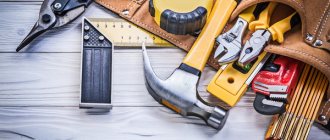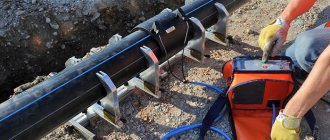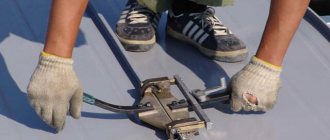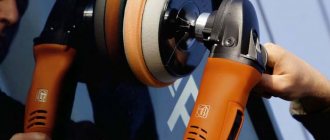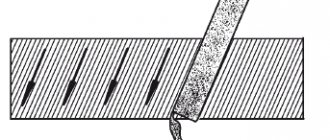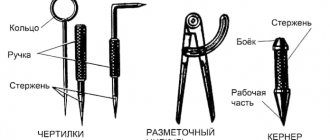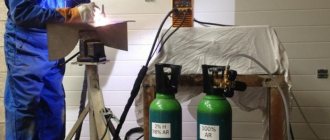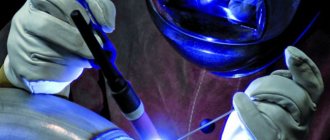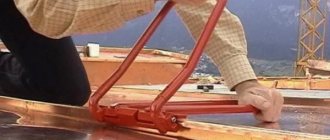There is not so much hassle with any roofing covering as with seam roofing. To lay this beautiful and reliable roof, you need such unusual types of equipment as roofing machines, sheet benders, guillotines, seams, special scissors and much more.
But don’t let this scare you: in fact, each tool for standing seam roofing is intended only for its specific stage of work, and it will take you 15 minutes to master it. Moreover, from year to year the construction market consistently pleases with new, more functional new products.
True, not all of these new products are clear enough and convenient for the average person, so we have prepared for you detailed photo instructions for using the most popular types of equipment and hand tools in this area.
How to choose quality equipment and tools?
People receive basic information about what tools are needed to install a seam roof from dealers. And they often need to sell the goods that are currently in stock, or that are simply profitable to sell right now.
Therefore, if you decide to deal with the seam roof yourself, then learn to choose the right tools. First of all, pay attention to the status of the brand.
For example, the more famous the brand and the longer this brand has been on the market and participates in exhibitions, the more likely such purchased equipment will work properly and last a long time.
The second important point is that all modern manufactured equipment for seam roofs is quite similar in design. So, there are a lot of offers on the market of machines for the production of seam roof panels. These are companies such as Draco and Schlebach (Germany), Dimos and Jouanel (France), Mobiprof (Russia) and smaller domestic ones.
The latter attract customers with their low prices and the external similarity of their machines with higher quality European ones. Although in fact the internal structure of such equipment is significantly different, because even if you want to completely copy the technology, patent law and existing production equipment will not allow it.
Therefore, a copy of itself is made with its own changes, tailored to the existing technological base and with a minimum production cost. But it is precisely these little things that distinguish a clone from the original that have a rather serious impact on the quality of manufacturing of a standing seam roof.
In fact, only experienced craftsmen are able to distinguish one equipment from another. This is why standing seam roofing manufacturers almost always have their own installation department and offer roofing installation services. And you shouldn’t refuse them, so as not to run into fake machines and the unpredictable quality of the roof itself.
How to increase the strength of machine mounts
There is another big drawback in the sheet bending machine - the way it is attached to the work table. Clamps, which are included in the provided device, are a very unreliable type of fastening, especially considering the rapid asthenicity of welding seams. These fastening parts can, in general, be abandoned, which will also eliminate the need to use welded mountings and jaws. The following steps can be used to solve this problem:
- Production of a support beam that will extend beyond the desktop;
- Making U-shaped lugs at the ends of the main beam;
- Fastening the main beam to the work table using bolts (M10) and shaped nuts with claws.
If the improved plate bending design does not have jaws, how do you attach the crossbar to it? This issue can be solved quite simply: use butterfly door hinges, which are traditionally used for hanging heavy iron doors. These hinges, which provide fairly high precision, can be secured using countersunk screws.
You can bend many blanks on a sheet bending machine with a traverse attached to butterfly hinges, since these hinges are very strong:
- Reinforced support beam;
- Flywheel - threaded part;
- Beam that provides pressing of the workpiece;
- Tripod for attaching the installation of elements to the desktop;
- A traverse with which you can bend the workpiece to be cut.
Listogiby: machines for cold bending of pictures
One of the main tools is sheet bending machines. These are special devices that are equipped with a circular blade for cutting metal.
Usually a team is hired to work with such tools. But it is important that at least one person has the necessary qualifications. After all, even on a simple roof there will be many complex components. In just one day, two teams of roofers cover up to 500 square meters of roofing.
In Russia today they mainly use European instruments:
The following Austrian brands are also known:
Attaching pictures to the base of the roof
A typical seam roof usually consists of the following elements: rolled materials approximately 600-700 mm wide, sheets 0.6-0.7 meters wide and 2-3 meters long, special elements for working with curved surfaces, as well as rhombuses, honeycombs and their analogues of a different shape, flat or three-dimensional.
The folds are secured using clasps pre-woven into them. And the roofing strips are fixed with self-tapping screws or nails where they will be covered with roofing material.
Remember also that a seam roof has many additional elements:
Here is the process of installing roofing pictures:
Folding machines: for large and small areas
For the production and installation of seam roofing, a mobile roofing machine is required. It is produced for renting paintings and closing double folds:
For example, such machines are produced in Russia, although such Western analogues as Wuko lock'n'rolle are also in demand.
To work with the roof of an ordinary private country house, it also makes sense to use modern equipment, which significantly improves the final quality of the roof. But for some reason, most teams still work the old fashioned way, using a traditional mallet and hammer.
It’s better to rent the necessary tools for a few days, and then the seams on the roof will be perfectly smooth and reliable. Moreover, the machine is usually capable of producing seam roofing from any roofing metal, be it copper, steel or aluminum.
So, let's take a closer look at what this tool is. Today, folding machines on the Russian market are provided by seven major manufacturers. This indicates the possibility of a good choice.
For example, an electric folding machine joins and closes profiled panels with a double standing seam. Moreover, she does this in one pass, quickly moving along the seam directly on the roof.
Advice: when choosing such a tool for yourself, it is better to give preference to a domestic one, since it is designed to withstand possibly careless handling during operation, and therefore has a more durable body and protection from moisture penetration.
Keep in mind that European folding machines are usually designed for a fold height of 25 mm, and American equipment is designed for 38 mm. Therefore, it is necessary to calculate in advance the compatibility of various equipment.
The fact is that for some machines you can adjust the height of the legs, while for others you will have to separately order such legs for 38 mm (and this is an additional cost). By the way, for small manual machines the issue of rebate height is not important.
Mobile equipment is installed directly on the roof and solid panels are made for double standing seams. Here it is important to purchase a really high-quality machine.
Otherwise, installers manage to cut the panels lengthwise into several parts, and then join these parts with rivets, which is absolutely wrong. This results in roofs made from expensive materials such as zinc or copper, but with big problems in terms of airtightness.
Here is an example of how such a machine works:
Mechanical folding machines are cheaper, but you will also work slower with them. There is also always a human factor - the risk of simply not pressing the fold.
The set of Mobiprof machines includes two machines for joining panels with a double standing seam. With a slight movement, you need to move the first machine in order to make L-shaped folds, and then the second machine to form the folded lock itself.
These machines have a special adjustment for the degree of clamping of the fold, which is very important for working with different types of metal. In this case, the seams are closed quite quickly, almost the same as with electromechanical machines.
The Wuko lock'n'rolle device is used to close rebates and double standing seam panels. It is convenient for them to work in any direction, but they will have to hold the machine itself with both hands, like a plane. Among the advantages we can name low price and weight.
Separately, we note such a seam-rolling machine as the Wuko 1006. It is small and light, and, perhaps, the only one that can be used for installing roofs of complex shapes, which have many junctions and transitions. The machine itself covers single and double L-shaped standing seams well.
It differs in its design from other models in that it has a special closing mechanism - a special hammer, which seems to tap the fold (while all other models press this fold with rollers). This is noticeable in his work: such a machine moves slowly, sometimes leaving marks on the metal. But it works great on any type of joint.
Let us note separately that quite a lot of folding machines were originally designed to work with expensive ductile metals. They are not suitable for rolling high-hardness galvanized steel.
There is also special equipment for making seam roofing on radius rafters. These are car models that differ from each other in terms of the minimum roof radius. Therefore, if you buy the wrong machine, you will also have to arm yourself with hand-held roofing tools to finish off the seams.
Look what all these cars look like:
Tips for choosing a bending machine
To choose the right mechanism for the production of bent elements from sheet iron, you must follow the following tips:
- For a home craftsman who occasionally needs a sheet metal bending machine, a simple device made from improvised materials is quite suitable.
- Those who occasionally carry out roofing installation orders will need a manual machine for bending sheet material and a simple zig machine.
- Professionals who are involved in the long-term production of elements for roofing systems and sheet metal work need a factory-installed sheet metal bending device.
- A manual mechanism for making corrugated sheets will be useful for those who professionally produce parts for roofing structures.
A professional installation, characterized by higher strength and durability, is considered suitable for such specialists, for example, the Russian factory sheet bender SKS-2v1, costing 64 thousand rubles.
Fine tuning of equipment
All supplied metal in rolls has a certain width tolerance. For example, for 1250 mm this is 5 millimeters. If you cut the roll with one pair of knives, you will get a half spacing of 2.5 mm.
But for profiled metal this is undesirable, because such unevenness over the entire width during the production of folded pictures will form ripples and lead to premature wear of both the machine and the mounting tool.
Most quality roofing machines are designed to be used exclusively in warm, clean rooms, like a workshop. They are not suitable for placing it outside in the open air. After all, different atmospheric conditions may have their own difficulties.
For example, trapezoidal threads easily become clogged, which leads to jamming and misalignment of carriages with profiled rollers. And such a machine will often have to be sent in for repairs.
It is also important to pay attention to the nameplate with the serial number of the machine and the coordinates of its manufacturer. This way you will understand whether such a machine was made in some garage. You can finally be convinced of the quality of the purchased mobile folding machine only after releasing the first roll. If you see ripples on the first sheet, things are bad.
But here we will make a small digression. An experienced roofer knows that even in a high-quality metal roll, with its exactly the same thickness along the entire length, the rigidity will vary. It depends mainly on the carbon concentration in the metal melt. Literally the next roll may already have different characteristics, although its stated metal thickness will be exactly the same.
In addition, it is of great importance what kind of metal you purchased to make your paintings. For example, relatively recently, metal from the Novolipetsk Iron and Steel Works with a thickness of 0.55 mm was the market leader. It had excellent stiffness ratings and was compatible with certain equipment.
But now quite a lot of offers have begun to come from all over the market, especially from China, which offers metal with a thickness of 0.4 mm. That is why manufacturers, receiving feedback from their customers, slightly adjust their equipment to new types of metal. Namely, the configuration of the forming rollers and calibration transitions.
For this purpose, for example, in models such as Mini-prof there are special plastic rollers at the very end of the machine. They can be adjusted and fine-tuned to the required metal hardness. That is, you roll the metal and constantly monitor the linearity of the panel, adjusting it so that there is minimal wave effect on the roof card.
Tip: Even the most expensive and precise equipment can produce defective roofing pictures. For example, if you leave a roofing panel that comes out of the machine perfectly hanging in the air. That's why be sure to install an additional table for this job.
Design of a sheet bending machine and its improvement
The installation of a manual sheet metal bending machine can be easily improved. To build a sheet bending machine, this scheme is used:
- Pillow made of wood;
- The main beam is made of channel 10−130 mm;
- Cheek, for the production of which a sheet 7-9 mm wide is used;
- Manufacture sheet subjected to finishing;
- A pressure beam made of 70-90 mm corners connected by welding;
- Rod for rotating the traverse (made from an iron rod with a diameter of 11 mm);
- The spacer itself is an angle with dimensions of 90-110 mm;
- The handle of the device is made of a rod with a diameter of 12 mm.
The sheet bending traverse, which according to the initial drawing is planned to be made from a corner, conventionally shows an option made from a channel. Such an improvement will several times increase the endurance of the traverse, which, when using a corner, at a certain moment will certainly bend in the center and will not form a high-quality sheet bend in this place.
Replacing with a channel will allow you to do not 250 bends without straightening or replacing the provided element (which is quite a bit for more or less constructive work), but more than 1400.
The design of this home-built sheet metal bending machine can be further improved, making it more efficient and versatile.
The second option allows you to understand in more detail the installation of a homemade sheet bender:
- A homemade clamp made from a suitable angle (50-70 mm) and a screw with a heel and a knob;
- Cheek;
- Beam acting as the reference point of the machine;
- Pressure beam bracket made from 120 mm angle iron;
- The pressing beam of the sheet bender itself;
- Traverse rotation axis;
- The traverse itself;
- Strengthening the pressure beam.
Below is a diagram of increasing the pressure bar. However, if you initially use a rather powerful corner as a clamp, and you don’t plan to bend extremely thick sheets on your sheet bending machine, then you can completely do without reinforcing the clamping bar using the described method .
In order to extend the service life of the pressure beam and make it comparable to the service life of the traverse, it is necessary to increase the provided structural element, which from the very beginning according to the drawing is made of a corner, with a base made of a metal strip with dimensions of 17x90 mm.
The front edge of the provided base must be given an angle of 45 degrees in order to level its area with the plane of the pressing corner itself, and specifically the working edge of the provided element must be chamfered about 3 millimeters. These measures will allow the clamp metal to act not on bending (which is extremely inappropriate), but on compression, thereby increasing the service time without repair many times:
- A special 61 angle bracket attached to the rear flange of the main clamp angle will keep it from bending upward.
- You should also think about milling the lower plane of the pressure beam, which forms the bend.
- The unevenness of the provided plane, according to generally accepted rules, should not exceed fifty percent of the thickness of the workpiece being bent.
- Otherwise, it will not be possible to bend the blank evenly, without a swollen fold line.
It is necessary to keep in mind that you need to submit a beam for milling only when it already has all the welds, since their execution leads to a change in the geometric characteristics of the structure.
Frames: hand tools for small areas
To perform work on a seam roof with European quality, you will need certain tools. And don’t be surprised that you will come across a variety of names for them, which often leads to confusion.
So, to work with seam roofing yourself, you will need the following devices:
So, first of all, you will need a mallet. Relatively recently, a wooden one was still used, but today a plastic one with a wedge shape is much more convenient. It is convenient to perform a whole range of operations.
Next, a hammer with a plastic tip for making double radius folds when you go around the fireplace chimneys. This plastic hammer does not damage the roofing at all.
You will also need a special steel spatula - an iron. With it you can install aprons around difficult areas of the roof. See exactly how all these tools are used in practice:
In addition, it happens that the seaming machine cannot be started from the end of the roof or used in short areas. Therefore, in such cases, frameworks will be needed.
Trimming and adjusting paintings
So, you will need to trim and bend all the paintings on the roof with special scissors:
To trim paintings, you will need universal scissors (otherwise called ideal scissors). Moreover, both right and left ones are needed to make the necessary workpieces without damage.
Another necessary tool is tweezers. Large, with a beveled angle at 45°, straight - with two angles at 45° for the manufacture of collars for chimneys and roof windows. Large pliers are needed to carry out beading up to 180 mm high.
But it happens that the depth of the round nose pliers is not enough, then they use a “heron” to make an abutment up to 150 mm high. All this is necessary in order to make a double fold when going around openings in the roof.
When the amount of work to be done is large, pelican scissors with a long cut are used. By the way, the very tool that we call a “parrot” is needed not as a nail puller, but as a special device for opening a double fold. You can’t do without it where you can’t use bending machines.
The finished paintings with curved edges are placed on the crate and connected to each other with clamps. The next step is to join such seams into a double fold using a manual or electric tool.
Design of roof ends and overhangs
The overhangs of a seam roof are designed as follows:
To work with the end of the overhang you will need all this:
Here's how to use this tool:
Roofing in the valley
To work with the valley you will need the following tools:
In practice it looks like this:
But to decorate the internal fractures of the roof, you will also need a mallet:
Types of sheet benders and their mechanism
Before you start making a sheet bending machine with your own hands, you need to clearly establish a list of tasks for which you need it. The main purpose of such a device will depend on what scheme it will be made according to. The most elementary is the mechanism in which sheet iron is bent using a special traverse. Using such a device, you can easily bend a sheet of metal at an angle of 90 degrees, using only hand strength without additional devices, if the width of the sheet is not more than 0.5 meters.
The base of the sheet is fixed using clamps or a vice, and its bending is carried out due to the pressure exerted by the traverse.
In certain cases, to obtain a turning angle of exactly 90 degrees, an embedded attachment may be useful , which is an ordinary strip of metal that will help compensate for the elasticity of the sheet.
A press brake, the system of which consists of a mesh and a punch, is considered more complex in design. Sheet iron in such a device is located on a matrix, and a punch descends onto the workpiece from above, giving it the required profile. In economic conditions, a sheet bending machine is unlikely to be used, since it is quite complex and unsafe to use.
A variation of the implementation of a homemade sheet metal press, operating in tandem with a self-made hydraulic press. If you already have a press, then adding devices for bending narrow sheets of metal will not be difficult. A sheet bending machine is considered more advanced, in which bending of iron is performed due to the action of three shafts .
This type of equipment is called a pass-through. One of its main advantages is that its controlled rollers allow different bending radii. A similar apparatus for bending metal can be manually or galvanically driven, and its rollers can have a variety of designs.
- Rollers with a smooth working surface are designed for performing many sheet metal works, which involve bending workpieces, manufacturing pipe sections with large diameters, etc.
- Profiled rollers are needed for bending parts of roofing units (ridges, boxes, gutters, flanges, etc.).
- The broaching machine can be equipped with a support, a clamp and a traverse, which allows it to be used for manual bending of blanks.
- Similar machines are equipped with a set of shafts of different profiles, which can also be purchased additionally to make the machine more versatile.
